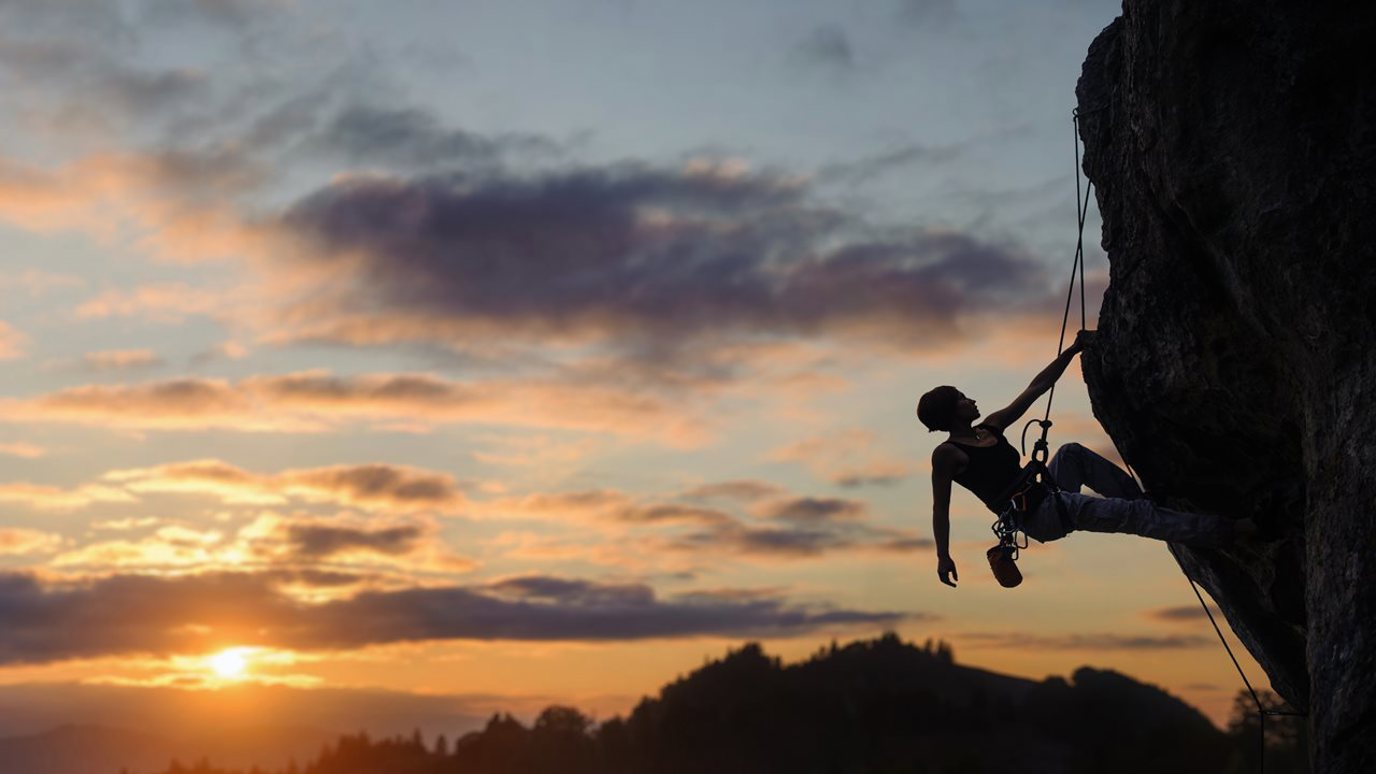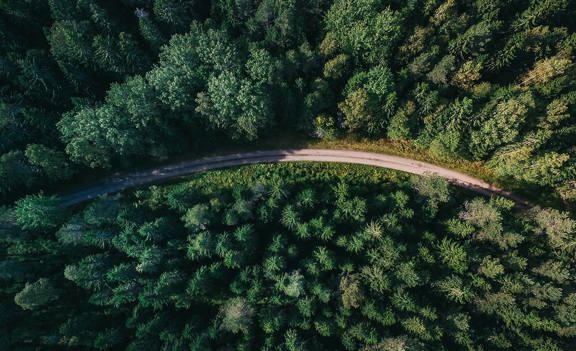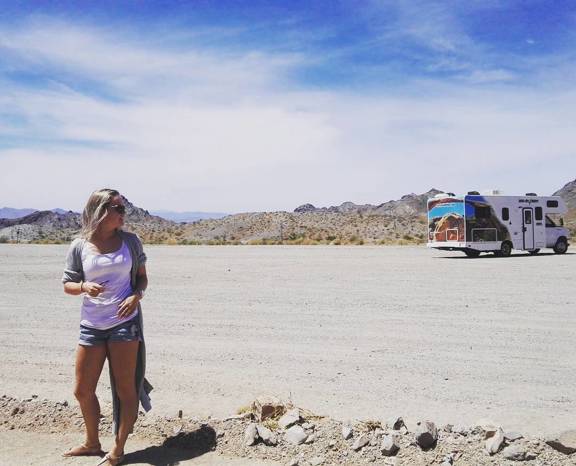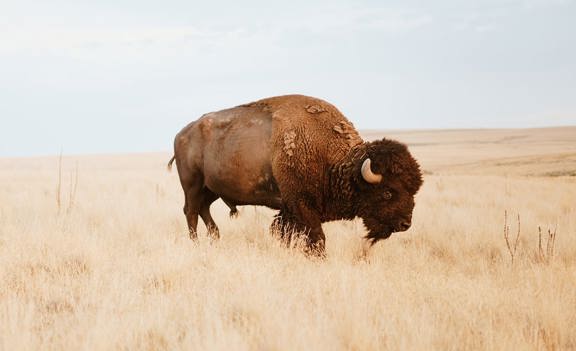
Even the most rugged, outdoorsy types of RV road trippers — you know, the sort who loves a good, strenuous hike on the uneven ground near their boondocking site, who isn't fazed by the stench of a campground dump station — can be intimidated by rock climbing.
Seeing people seemingly hanging on for dear life on the rock face of a mountain makes any sensible person's stomach churn — unless they're primed for adventure, in which case rock climbing may be their next great personal challenge (and fear) to overcome!
Ready to get started? Well, before you grab your rope, carabiners, and harness, have a look at all the "Beta" (the information you need) on rock climbing for beginners!
Why You Should Try Rock Climbing
If you're one of those people who are considering taking up rock climbing, there's a lot you need to know. Before getting into that, it's worth asking why people go rock climbing to begin with.
So, why do people go rock climbing? Individual reasons obviously play a role, but having a look at the physical and mental benefits of climbing can provide you with some big clues.
Climbing is a Total Body Workout
Rock climbing is a total body workout, engaging your arms, legs, core, and back; it works your muscles in a variety of ways, helping you build several types of physical strength and endurance.
As it's also an aerobic workout of sorts, rock climbing can help improve cardiovascular fitness and lung capacity, too.
The Mental Benefits to Climbing
Then there are the mental benefits: Rock climbing demands intense, sustained focus and concentration. It can aid in strategic thinking as you figure out how to work your way up a route and forces you to make decisions faster (don't overthink).
As you achieve more successful climbs, your confidence will go up — and your stress levels will go down!
The Different Kinds of Rock Climbing
What are the different kinds of rock climbing? Some of the most popular kinds of rock climbing are trad climbing, sport climbing, bouldering, and top roping.
Trad Climbing
Trad climbing is just as it sounds, with "trad" being short for "traditional". With trad climbing, you ascend a face with the help of bolts/anchors placed by a lead climber. Safety is emphasized over speed, with the lead climber finding the best "route" (path of a specific climb) to the top.
Sport Climbing
Sport climbing is more strenuous, emphasizing strength, speed, and style. In sport climbing, you ascend a rock face using permanent (pre-placed) anchors/bolts and "quickdraws" (two carabiners attached by a sling), and you may need to have some gymnastics ability to make it to the top.
Bouldering
Bouldering is a type of climbing done relatively close to the ground and without the help of a rope, sometimes with a "crash pad" (foam mat) placed on the ground below you.
In its more extreme form, you can "free solo" high above the ground without anything (or anyone) to catch you if you fall.
Top Roping
Top roping involves climbing a rope attached to an anchor at the top of a cliff (or, indoors, of a climbing wall), with the rope securely held by a "belayer" (the person who manages the rope) below.
You ascend slowly in top roping, methodically, as the belayer prevents you from falling too far if you lose your grip.
What’s the Best Type of Rock Climbing for Beginners?
As a beginner rock climber, you're going to need a lot of practice and help, and you'll fall more often than you think. Since top roping is one of the best and safest ways to literally find your footing and gain confidence, that's what this guide will focus on to help you, ah, learn the ropes!
Rock Climbing for Beginners: A Step-by-Step Guide
Wait, what about the lingo? Doesn't rock climbing have a whole vocabulary you should familiarize yourself with? Yes, that's true — learning the lingo of rock climbing is important (which is why important rock climbing terms have been included in italics).
You can figure out the difference between an "Arête" (a narrow ridge of rock) and an "Abseil" (also known as "rappelling") later on; for right now, just follow this step-by-step beginner's guide to rock climbing to learn how to rock climb safely!
1. Grab Yourself Some Gear
Before you start climbing, you'll need to obtain the proper rock climbing gear, such as a harness, climbing shoes, a belay device, a locking carabiner, a good rope, and a helmet.
Of course, if you're planning on taking classes at a climbing gym, you can rent this gear from them, which will help you become more familiar with it all.
If you plan to continue climbing out in the real world once you've completed your lessons at a climbing gym, you'll need to buy gear on your own.
2. Find a Climbing Partner
It's important to climb with a partner when top roping; after all, you need someone to hold and control the rope from the ground as you ascend and then descend, or you're gonna have a bad time!
Make sure you find a climbing partner who is experienced and comfortable with belaying; if they aren't, perhaps take a belaying class together, so you can both know what you're doing.
Is there no one around you available to act as your climbing partner? Then find a climbing gym in your area!
Climbing gym employees are exactly the sort of experienced climbing partners you want; plus, acting as a belayer is usually in a climbing gym employee job description!
3. Set Up the Anchor
To set up the anchor, one climber (the belayer) should secure the rope to a sturdy anchor point at the top of the climb, such as a tree, bolt, or some other natural feature. The rope should be long enough to reach the bottom of the climb, with some extra slack for the climber to work with.
If learning how to top rope at a climbing gym, the anchor is usually set up for you. If you want to learn how to set up an anchor on your own, your gym may provide lessons on how to do so!
4. Put on Your Harness
Once the anchor is set up, you put on your harness and tie into the rope. You'll need to use a figure-eight knot, making sure it is properly secured and tightened.
Once that's done, don't take your safety for granted: Double-check that your harness is properly adjusted and tightened before you start your climb; for ultimate peace of mind, you can ask your climbing partner to check your knot and harness, too.
5. Start Your Climb
Finally! This is it, the moment of truth! As the belayer holds and controls the rope from the ground, you should begin to climb up the route.
Use any holds, cracks, and other features (also known as "holds") you come upon to help you make your way to the top, but don't rush; as a beginner, it will take time to learn which features, cracks provide you with the best grip.
As you ascend, the belayer on the ground will keep the rope tight, but not too tight. Why? This allows you, as the climber, to move freely — but also provides a secure catch in the event you fall!
6. Finish the Climb...And Head Back Down
Once you reach the top of the climb, you're done, right? Nope! You have to head back down the same way you came up. At the top, clip the rope back into the anchor, check with your belayer on the ground, and begin your descent. As you descend, the belayer will securely hold the rope, ensuring you reach the ground slowly and safely.
7. Become the Belayer
Once your climb is completed, it's time to switch positions with the partner who acted as belayer for you. Hold the rope tightly, and be sure to give the climber enough slack so they can (as you did) freely choose between any features that can help them reach the top.
Once they've completed their ascent, they'll wait for you to be ready so they can come down, too; in the same way they did for you on your way down, control the rope to control and slow their rate of descent.
What If You're at a Climbing Gym?
Keep in mind that at a climbing gym, you won't necessarily follow all of these steps; for example, the anchor will always be set for you at the top of a climbing wall.
You also won't need to switch positions with the climbing gym instructor acting as your belayer once you reach the floor unless you actually want to gain belaying experience and the instructor is willing to help.
Remember: Every Rock Climbing Type is Different
With other popular forms of rock climbing (such as trad, sport, and bouldering), the steps may be very different from those outlined above.
For instance, bouldering doesn't involve any ropes at all, making you rely more on the cracks, natural features, and other holds as mentioned in Step 5; in trad climbing, though, anchors are placed and removed as you go up — you have to get comfortable doing that yourself.
Should You Join a Climbing Gym?
The importance of properly learning how to climb cannot be stressed enough; it could make the difference between life or death (or, at the very least, can help prevent falls and serious injuries as a result!).
It is, therefore, highly recommended that you take lessons at a climbing gym near you. These have exploded in popularity in recent years, especially as more people have discovered the health benefits of rock climbing, such as improved mental and physical fitness.
Taking lessons at a climbing gym will help you gain confidence with rock climbing faster than you could get trying it on your own. It won't be long before you're out climbing in the wild!
Go Rock Climbing with a Cruise America RV Rental
Ready to try rock climbing as it was meant to be experienced? Grab yourself a Cruise America RV rental, and lay in a course for the best rock climbing destinations in North America.
Cruise America has the perfect RV for your next rock climbing adventure, so visit Cruise to find yourself a fantastic RV rental today!





